YEAR-IN-REVIEW 2023:
Automotive Industry Trends + 2024 Outlook
Automotive Industry Experts Share The Strongest Predictors for 2024
Every calendar year, momentous events take place that define the present and shape the future, evolving as time progresses. Cloud Theory’s unique automotive industry trends perspective on comprehensive supply and demand points to five major issues that will dominate the automotive environment in 2024.

01
Supply Dynamics
A look at the rapid increase of new vehicle inventory due to the easing of post-COVID supply chain issues, though not without continuing challenges and complexities
02
Demand Dynamics
How buying behaviors have shifted in relation to the supply rebound and the likely impact this will have on pricing and incentives
03
Electric Vehicles
The ever-evolving trends associated with EVs as OEMs calibrate their investments and production in this sector to meet looming regulatory requirements
04
Economic Influences
The impact of inflation and higher interest rates on model and trim selections
05
Inventory Efficiency
A view of the top 10 makes that got more than their fair market share given their relative inventory position in the marketplace

Top 5 Major Trends that Will Dominate the Automotive Environment in 2024

01
Achieving 3 Million Monthly New Vehicle Count by Year End: Not Just Attainable, but Highly Probable.
According to our data and sources, it is almost a given that inventories will continue to grow, but there are still some residual headwinds that will put a ceiling on how high production can go. Here's why.
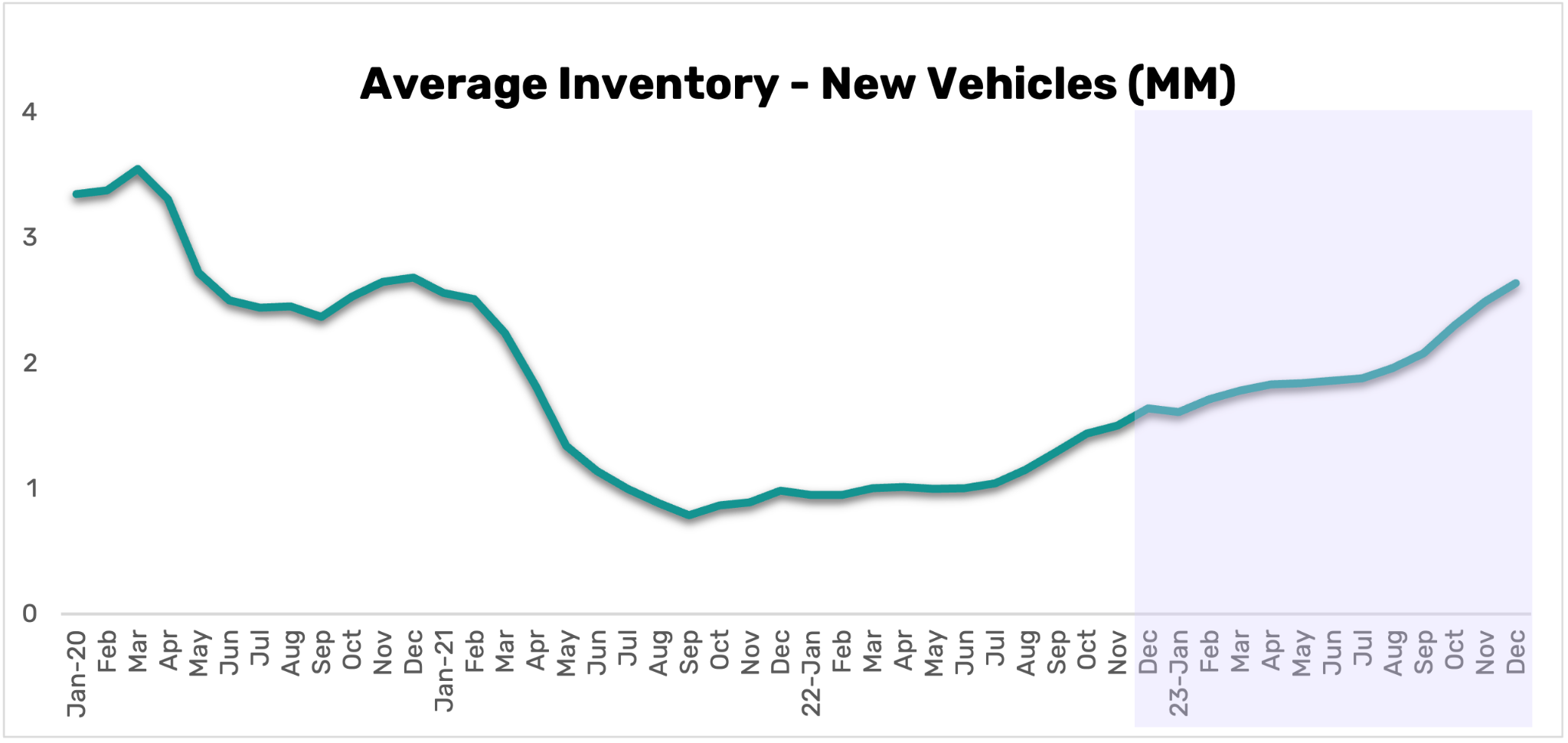
02
Persistent Parts and Manufacturing Challenges: Expect Sustained Supply-Demand Imbalance, ~30% Turn Rates, and $2,000 Marketed vs. MSRP Gaps.
In 2024, OEMs will be operating in a more challenging environment than has been in place for the past three years, and these manufacturers will have to work harder to push demand for their vehicles in an increasingly supply-driven market. View Full Details.
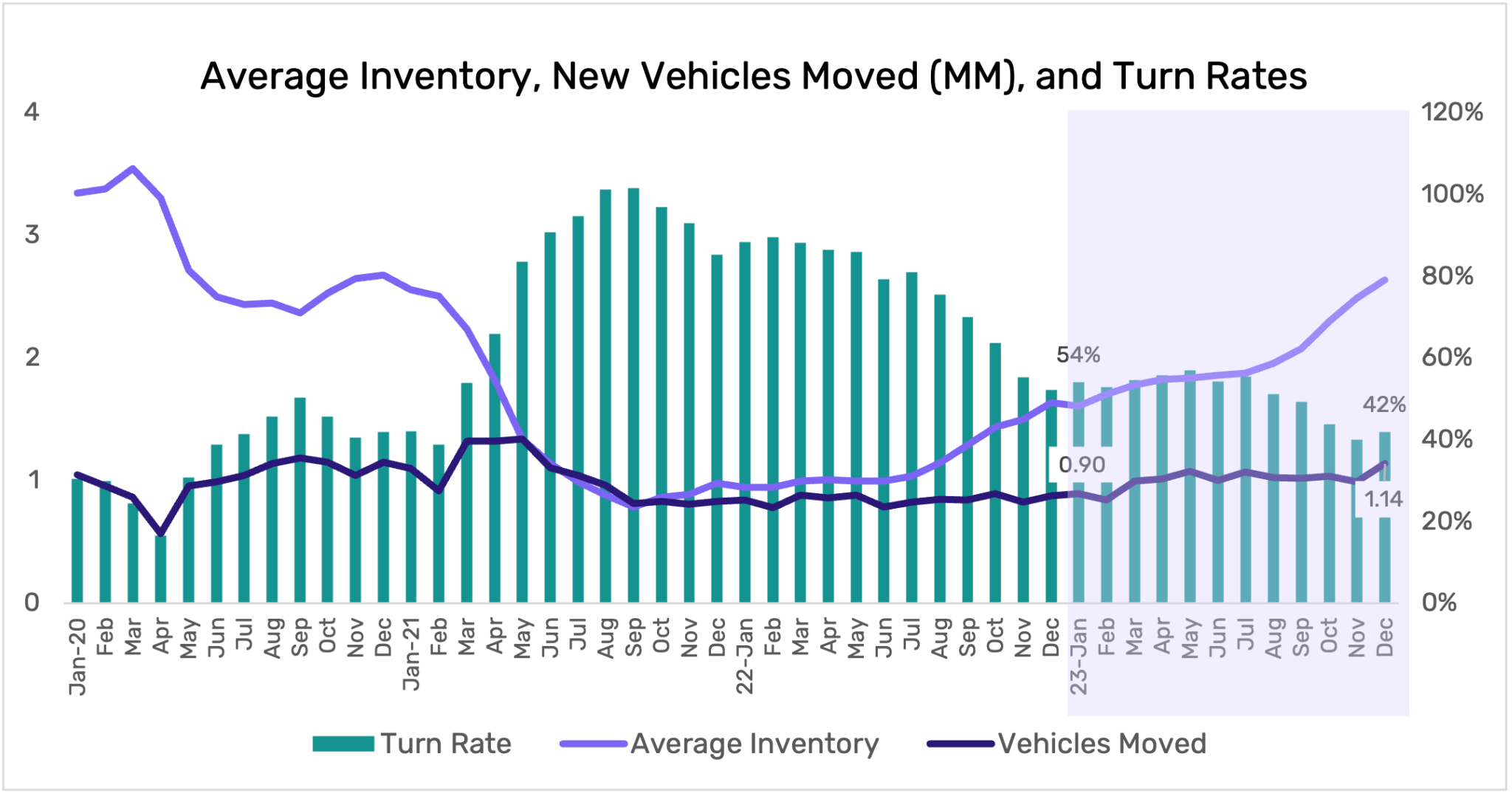
03
EV Turn Rates Languished Below 30% for Much of the Latter Half of the 2023, While Days-To-Move Doubled From the Mid-30s to the 70s.
Cloud Theory has previously published a comprehensive EV Report entitled “Charging Ahead: Which EV Brands Will Dominate the Next Decade?”, which provided a detailed view of each OEM’s past, present, and future state in this dynamic and ever-evolving space.
The EV industry will continue to make headlines as OEMs navigate production issues, pricing and profitability considerations, regulatory shifts, battery innovations, charging infrastructure development, consumer concerns. Learn More.
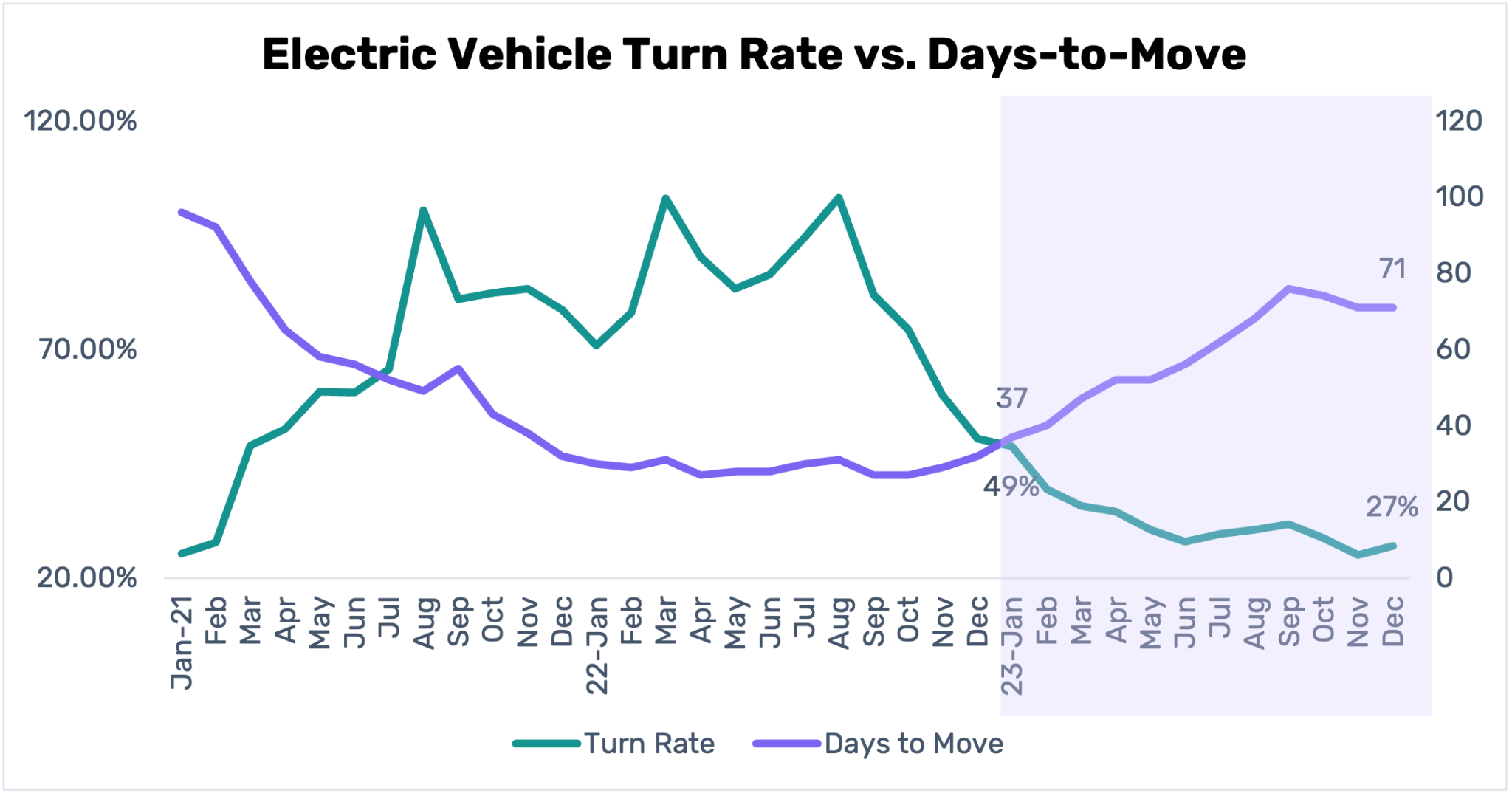
04
Driving Expenses Surge: Consumers Grapple with Over $100 Monthly Spike in Average Car Payments, 2023's Multi-Faceted Increase Unveiled.
The interest rate increase on vehicle loans that began in spring 2022 continued throughout 2023, as the Federal Reserve instituted multiple hikes to combat accelerating inflation. With 2024 looking similar to 2023 in terms of interest rates, manufacturers will be well served to offer a balanced portfolio of vehicle trims that best suit the economic realities that consumers will continue to face. See why.
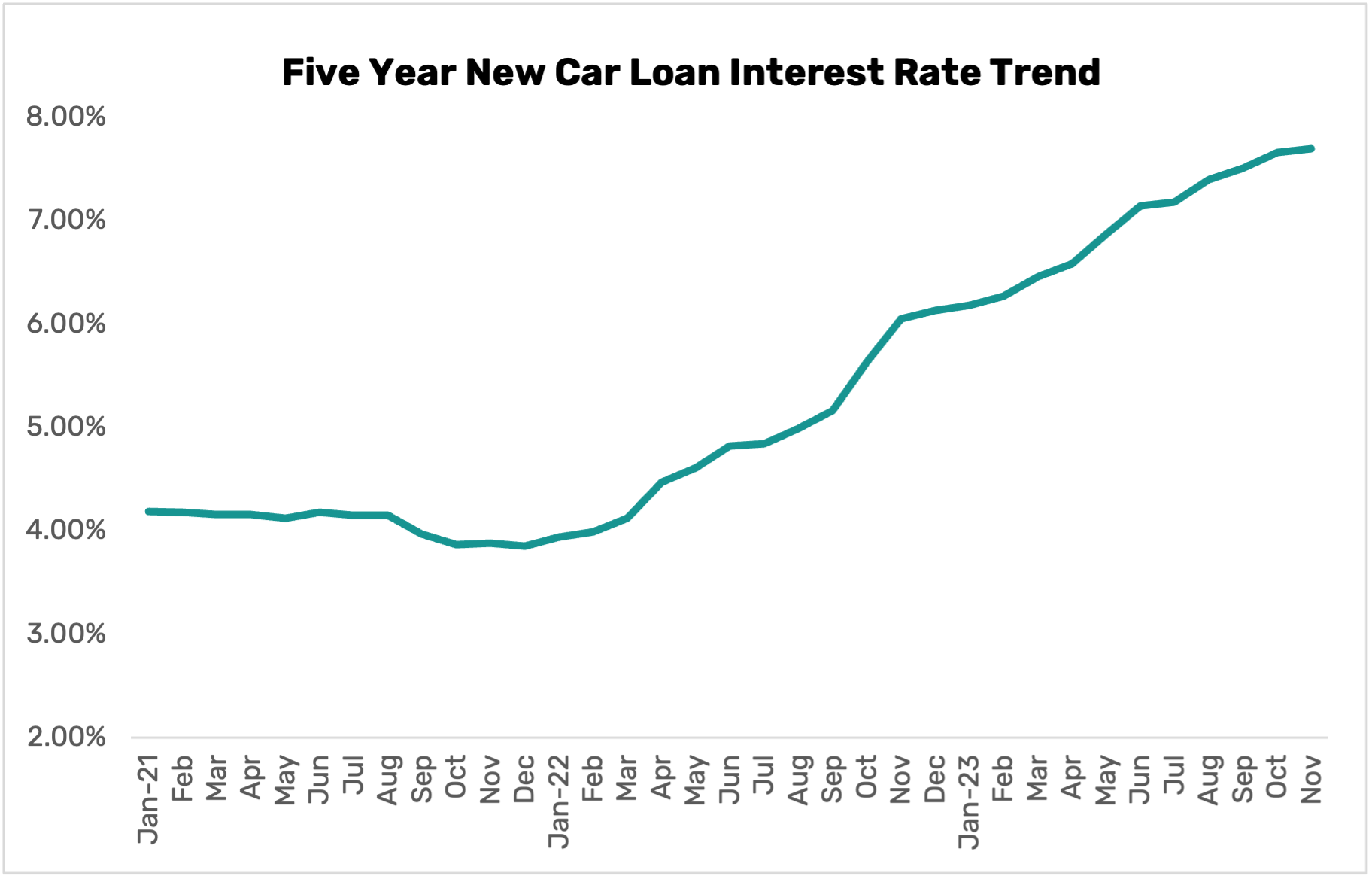
05
Eight of the Top 10 Makes Carried Over From 2022 to 2023, the Rise of General Motors Brands Demonstrates That Moving Upwards Is Achievable.
With this in mind, the makes that are getting more than their fair market share relative to their inventory share have an inherent advantage. View Details.
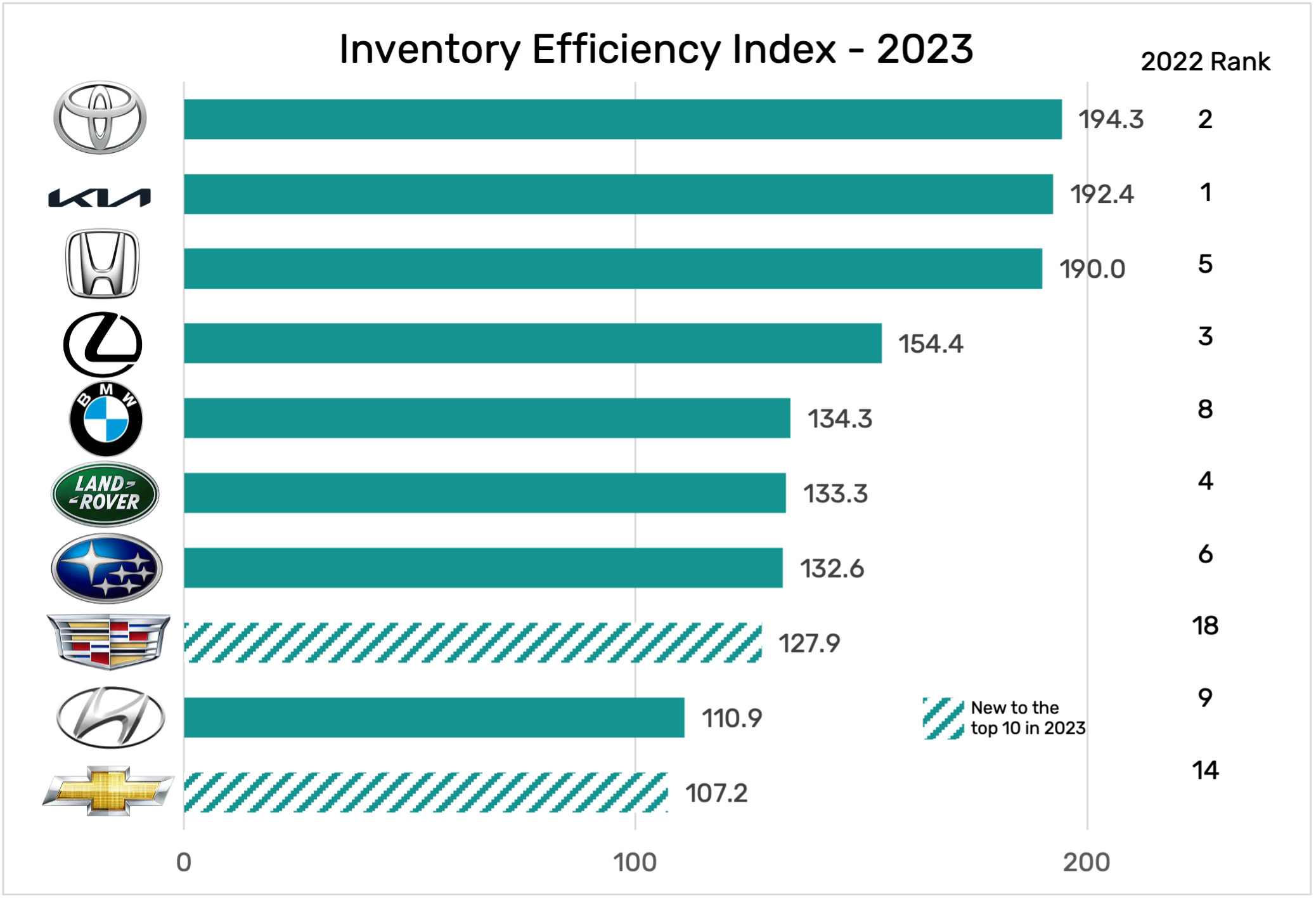
What Are Automotive Industry Trends?
Automotive Industry Trends encapsulate the dynamic and evolving directions shaping the automotive sector today and into the future. These trends reflect how companies within the industry are innovating and adapting to meet the changing demands of technology, regulation, consumer behavior, and the global economy. Key areas of focus include:
- Electrification: The shift towards electric vehicles (EVs) as part of a broader commitment to reducing carbon emissions and promoting sustainable mobility solutions.
- Autonomous Driving: The development of self-driving technologies aimed at enhancing safety, efficiency, and accessibility in transportation.
- Connectivity: The integration of connected car technologies, enabling vehicles to communicate with each other, infrastructure, and the internet to improve the driving experience and vehicle functionality.
- Sustainability: The adoption of eco-friendly manufacturing processes and materials to minimize the environmental impact of vehicle production and operation.
- Digital Transformation: The digitalization of customer interactions and operational processes, from the car buying experience to after-sales services, reflecting the industry's shift towards a more service-oriented approach.
- Mobility-as-a-Service (MaaS): The transition from vehicle ownership to mobility solutions that offer on-demand transportation services, underlining changing consumer preferences and the rise of the sharing economy.
- Supply and Demand Dynamics: The balance between the supply of vehicles and consumer demand is a critical factor driving the automotive industry. Economic conditions, advancements in vehicle technology, global supply chain challenges, regulatory changes, and evolving consumer preferences all influence this dynamic balance. Automakers must continuously adapt their production strategies and vehicle offerings to align with these shifting supply and demand trends, ensuring they can meet market needs while optimizing operational efficiency and profitability.
These trends collectively represent the forefront of innovation in the automotive industry, highlighting the pathway towards a more sustainable, efficient, and technologically advanced future in mobility. Understanding these trends is essential for industry stakeholders, including manufacturers, suppliers, policymakers, and consumers, to navigate the challenges and opportunities presented by the rapidly changing automotive landscape.
01
Achieving 3 Million Monthly New Vehicle Count by Year End: Not Just Attainable, but Highly Probable.
New vehicle inventories ended 2022 at 1.64 million—more than double the supply chain-challenged low of September 2021, but still well below historical (i.e., pre-pandemic) levels. For eight months, those inventory levels were on a slow but steady climb, adding an average of 2.9% each period. In September 2023, inventory levels surpassed 2 million for the first time in two-and-a-half years as supply gains accelerated, and the last three months of the year added 11%, 8%, and 6% to supply counts. 2023 inventories ended exactly one million vehicles higher than a year prior.
2023 inventories ended exactly one million vehicles higher than a year prior.
This recent rapid ramp-up is a reflection of supply chain issues easing and a shared desire across all OEMs to fill their pipelines and introduce/refresh vehicles after two years of delays and deferrals.
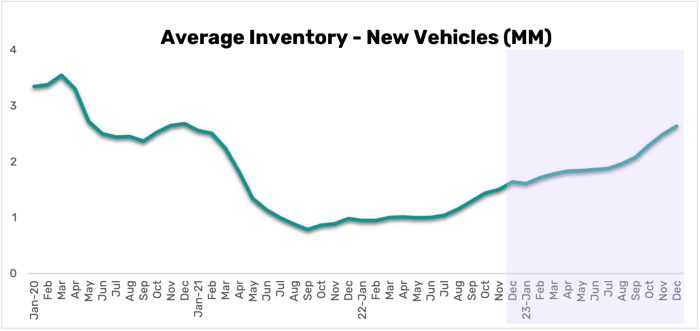
2024 Outlook and Key Considerations
The inventory dynamics of 2023 will undoubtably continue to echo into 2024, though it’s impossible to predict the exact inventory levels that will be reached. It is a safe bet to say that supply levels will continue to accelerate, and even a 1.5% compounded monthly rate of growth would push average monthly new vehicle counts above 3 million by the end of the year. How the inventory situation plays out over the next year (and beyond) is subject to two interrelated factors: shorter-term and longer-term.
...Supply levels will continue to accelerate, and a 1.5% compounded monthly rate of growth would push average monthly new vehicle counts above 3 million...
Shorter-Term Factor
The short-term factor is that supply chain disruptions, while easing, will continue into the new year. A recent Deloitte study pointed to a situation in which parts suppliers are unable to fulfill the demands of their OEM customers due to economic vulnerabilities that started during the parts shortage crisis and continue as inflation and interest rates have weighed on bottom lines.
“Although the OEMs were able to turn the [parts shortage] situation to their advantage through increased pricing and profitability, suppliers were largely left to struggle with the low-volume environment that was accentuated by production planning instability and expedited freight.” Additionally, “the prolonged inflationary environment is applying significant pressure to a relatively vulnerable supply base that is struggling to find the resources necessary to invest in future products and solutions.”
These pressures and vulnerabilities have increased the likelihood of supplier bankruptcies, exacerbating the risk of delayed parts deliveries and the perpetuation of production disruptions.
Longer-Term Factor
A Boston Consulting Group study found that, prior to the pandemic, “Supply chain systems and management practices have long favored optimizing operations by making supply chains as lean as possible, while simultaneously pressuring suppliers to reduce costs and inventory. Current just-in-time approaches leave little buffer to absorb disruptions.”
The aftermath of the COVID-19 pandemic has led many OEMs to rethink this approach and to begin focusing on ways to simplify production, logistics, and parts procurement through more direct partnerships and alliances (especially in the EV sector) and to improve understanding of their supply chains in order to anticipate issues and react more rapidly when they occur.
In September 2023, for example, Ford Motor Company announced that it would restructure its supply chain to “support efficient and reliable sourcing of components, internal development of key technologies and capabilities, and world-class cost and quality execution.” This includes the formation of a Chief Supply Chain Officer position, reporting directly to CEO Jim Farley.
Ford is not alone in making these moves. According to an industry analysis performed by Capgemini Research Institute, “automakers have been forced to rethink, restructure, and refinance their supply chain management.” The report goes on to say that “A global re-orchestration is underway as procurement from offshore locations fell by 22% in the past two years.”
The migration toward EVs is accelerating the pursuit of restructuring tactics such as “giga-casting,” which is the production of integrated vehicle systems in larger sections rather than the assembly of multiple parts from a myriad of suppliers. The simpler structure of an EV powertrain compared to an ICE one (20 parts vs. 2,000) drives this shift, but it is also being applied to more traditional vehicle systems as time progresses.
While progress on these fronts is being explored and pursued, another aspect of the response to supply chain challenges has been slower to take hold. Having detailed visibility and insights regarding suppliers—especially second-tier vendors—has proven to be difficult, and this impediment is likely to continue until OEMs put more formalized mechanisms to track these complex ecosystems into place. As the BCG analysis put it, “companies lack adequate supply chain visibility. Supply chains have become so complex that automakers are frequently unable to identify suppliers beyond tier one. As a result, automakers do not know these suppliers’ manufacturing locations, lead times, and production and shipment track records—or even the parts or materials they supply.”
That same BCG analysis drew from a survey performed in 2022 across various industries to determine supply chain resiliency. The vast majority of respondents indicated that their companies were reactive, with slow response time and low levels of structural operations to deal with disruptions. Most notably, all automotive responses were in that reactive quadrant.
Automotive Companies Are Unprepared for Disruptions
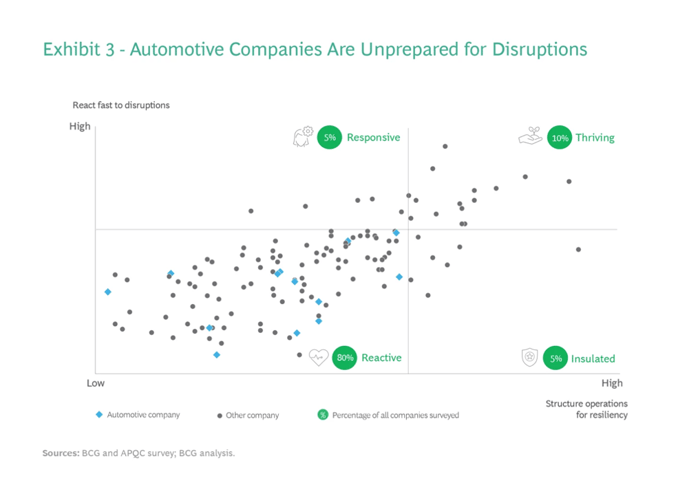
The Ford efforts noted above are an example of how it and other OEMs are taking a long, hard look at their supply chain knowledge and planning in light of the disruptions that took hold in 2021 and continued to wreak havoc over the next two years. But this is by no means a short-term fix; it will be a long-term transition to build a new model to replace long-standing just-in-time practices that have ruled the day for many years.
Assessment
Overall, it is almost a given that inventories will continue to grow throughout 2024 as OEMs move to fill product pipelines, launch new vehicles, and pursue refreshes that were previously delayed or deferred. Getting to an average monthly new vehicle count of 3 million by the end of the year appears not only attainable but likely.
It is almost a given that inventories will continue to grow ...but there are still some residual headwinds that will put a ceiling on how high production can go
But while supply chain issues are definitely easing and OEMs are placing greater focus on their management and simplification of them, there are still some residual headwinds that will put a ceiling on how high production can go.
These come in the form of continuing supplier disruptions due to enduring economic and financial issues (particularly at the second-tier level and below) and lack of detailed knowledge of and visibility into complex parts systems in order to affect change.
Explore Our Sister Resource: Supply Dynamics Insight
Auto Industry Adds One Million Vehicles to Inventory Since September 2021 Low
Jump to the Top of This Navigator
02
Persistent Parts and Manufacturing Challenges: Expect Sustained Supply-Demand Imbalance, ~30% Turn Rates, and $2,000 Marketed vs. MSRP Gaps.
For the first seven months of 2023, turn rates held somewhat steady in the mid-50 percent range as vehicle movement generally kept pace with slowly recovering inventory levels. While these levels were certainly lower than those seen over most of the prior two years—which were artificially inflated by resilient demand and very short supply—they were still higher than pre-pandemic era velocity when less than one-in-three available vehicles moved in a 30-day period.
But as summer gave way to fall and inventory counts began to accelerate, movement stayed stubbornly near 1M per month, and turn rates began to drop, hitting 42% at the end of the year and down 12 points from where 2023 began.
In the process, marketed prices slowly fell further below the MSRP, though not nearly to the $2,000+ differentials that defined the time before inventory shortages ruled the day. At the same time, the days-to-move metric slowly extended from 46 to 55 days but, again, did not come anywhere near levels of more than 90 days in the period prior to the pandemic and in the early days after the outbreak.
Average Inventory, New Vehicles Moved (MM), and Turn Rates
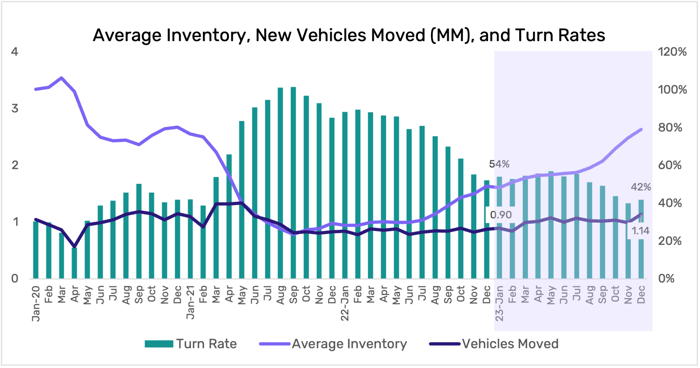
Days-to-Move
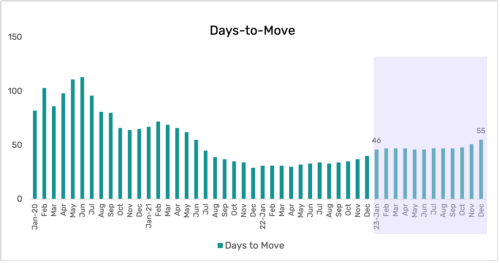
Pricing Differential - Marketed Price vs MSRP
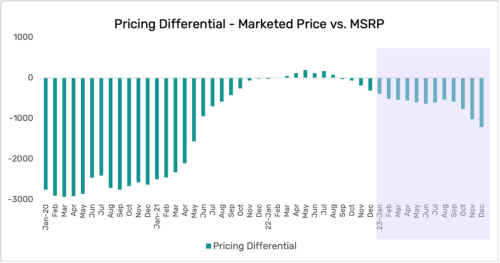
2024 Outlook and Key Considerations
Prior to the pandemic, when inventories were plentiful, and vehicles sat on dealer lots for an average of more than 90 days, OEMs (and dealers) had to work hard to make a sale. One of the main tactics was aggressive incentives, and the percentage of average offers in relation to transaction price had increased to 11.1% in 2019. But over the course of the next three years, dwindling supplies and resilient demand had rendered incentives all but unnecessary. By the end of 2022, the average incentive offer was down to just 2.2% of transaction price.
With inventories climbing and demand remaining static in 2023, however, incentives began to make a comeback. At the end of the year, average offers had rebounded to 5.2% of transaction prices. A far cry from the exceedingly high pre-COVID levels, but certainly heading back in that direction.
This begs the question of how aggressive OEMs will need to be in 2024 to compete in an environment where the pendulum has swung toward oversupply. In 2023, prices had already started to come under pressure, and it is predicted that this will increase and accelerate as manufacturers replenish their stocks in the face of static demand. Persistent inflation and ballooning interest rates also heavily impacted consumers’ ability to pay premium prices for vehicles in 2023, and will continue to have an impact as 2024 progresses.
A December 2023 Automotive News article summarized these factors as follows: “Rising interest rates, often above 7%, and tightening credit have sidelined a portion of consumers, and that could hinder sales of the replenished dealership inventory that automakers spent most of 2023 building back. Vehicle prices are stabilizing even as automakers begin to toss aside some of their incentive discipline of the past four years. Discounting also is expected to increase, and both factors will continue to push average transaction prices down.”
Assessment
In 2024, OEMs will be operating in a more challenging environment than has been in place for the past three years, and these manufacturers will have to work harder to push demand for their vehicles in an increasingly supply-driven market. The industry is decidedly heading in the direction of higher incentives and increased pricing pressure at a time when labor costs are already squeezing profit margins.
As noted in the previous section of this report, parts and manufacturing issues will continue to linger, which will likely keep the supply-demand imbalance from reaching pre-pandemic levels and the ~30% turn rates and $2,000 marketed vs. MSRP gaps that accompanied them.
But it is almost a given that 2023 trends will continue to push the industry closer to those levels as 2024 goes forward.
The industry is decidedly heading in the direction of higher incentives and increased pricing pressure at a time when labor costs are already squeezing profit margins.
Top Resources on Demand Dynamic
- After Years of Vehicle Price Increases, a Small Dip
- Analyzing Inventory Trends in Major Car Brands: What the Data Reveals
Jump to the Top of This Navigator
03
EV Turn Rates Languished Below 30% for Much of the Latter Half of the 2023, While Days-To-Move Doubled From the Mid-30s to the 70s.
Cloud Theory has previously published a comprehensive EV Report entitled “Charging Ahead: Which EV Brands Will Dominate the Next Decade?”, which provided a detailed view of each OEM’s past, present, and future state in this dynamic and ever-evolving space.
2023 was a watershed year in terms of the EV evolution, with numerous introductions and production ramp-ups on existing models across most major manufacturers. This focus on EVs was driven by looming EPA regulations, which will require two-thirds of new vehicle production to be electric vehicles at the beginning of the next decade.
Over the course of the past twelve months, the share of (non-Tesla) inventory doubled, growing from 2.8% to 5.7%. Market share, on the other hand, increased at a slower rate and plateaued mid-year. Turn rates continued a late 2022 decline in the early part of 2023 and languished below 30% for much of the latter half of the year, while days-to-move doubled from the mid-30s to the 70s.
Electric Vehicle Inventory Share vs. Market Share
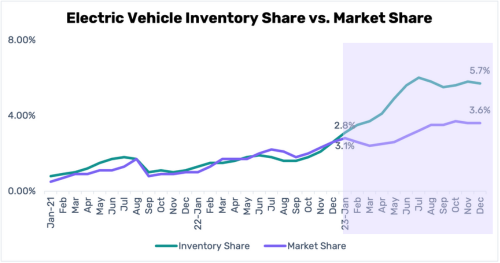
Electric Vehicle Turn Rate vs. Days-to-Move
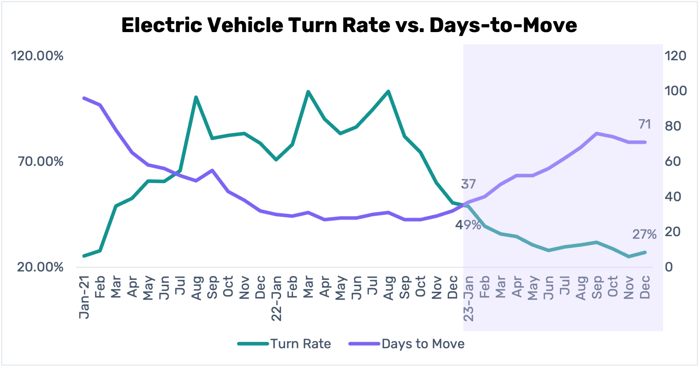
2024 Outlook and Key Considerations
The EV sector of the automotive industry continues to be a moving target, with manufacturers recognizing that demand is languishing but still needing to progress in anticipation of regulatory realities. Pricing, manufacturing, regulatory, and competitive dynamics continue to shift rapidly as the industry evolves from ICE-dominated production to more of an EV orientation. Even in the short period since the publishing of Cloud Theory’s EV report, a variety of OEMs have evolved their actions and positions on EVs. For example:
- The number of EVs qualifying for the $7,500 tax credit dropped to thirteen after Biden Administration rules changes that kicked in on January 1, 2024.
- China’s BYD overtook Tesla sales leadership in Q4 2023 despite a record quarter for the latter.
- Tesla achieved its record quarter in part due to aggressive price cuts.
- Ford announced a postponement of $12B in EV investment due to slowing demand, pricing pressure, and higher UAW costs. Relatedly, Ford announced that it would scale back its F-150 Lightning production by approximately half.
- General Motors missed their EV manufacturing goals by half as production problems persisted in 2023. Meanwhile, quality and recall issues have emerged for models such as the Chevy Blazer EV.
Assessment
While it is hard to predict the details of how 2024 will unfold regarding electric vehicles, it is a given that this sector of the industry will continue to make headlines as OEMs navigate production issues, pricing and profitability considerations, regulatory shifts, battery innovations, charging infrastructure development, consumer concerns, and much more. We are still in the opening chapters of a story yet to be written, but the narrative that begins to emerge will be one that everyone in the industry pays attention to in 2024…and beyond.
Dive into Our Newest Electric Vehicle Article
Electric Vehicles Face an Uphill Battle to Hit Sales Targets
Jump to the Top of This Navigator
04
Driving Expenses Surge: Consumers Grapple with Over $100 Monthly Spike in Average Car Payments, 2023's Multi-Faceted Increase Unveiled.
The interest rate increase on vehicle loans that began in spring 2022 continued throughout 2023, as the Federal Reserve instituted multiple hikes to combat accelerating inflation. Coupled with trends that have brought prices more in line with MSRP (see chart in section #2 of this report), consumers faced a multi-faceted increase in car purchase costs. The average monthly car payment in 2023 hit $726, an increase of more than $100 from 2021 levels.
.png?width=700&height=368&name=five%20year%20new%20car%20loan%20interest%20rates%20(1).png)
Source: www.Statista.com
With inflation on energy, food, and many other items also taking a bite out of consumers’ buying power, consumers exhibited compromises in their vehicle choices. Higher end trims experienced more pronounced turn rate declines in 2023 than their mid-range and base trim counterparts. Segment-level examples shown below represent a broader trend, with many vehicles seeing declines at the higher end of the range.
Turn Rate Change - Mid-Size SUVs (2023 Trim Price)
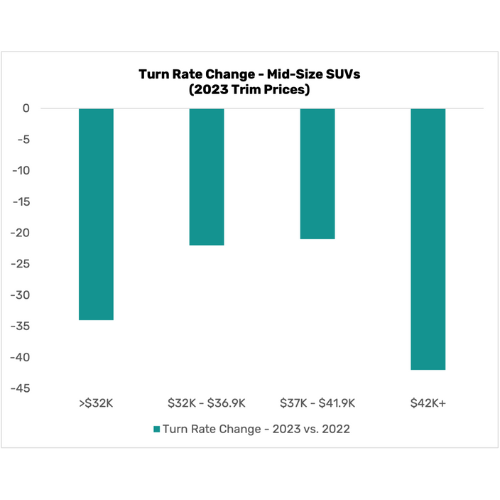
Turn Rate Change - Full-Size Trucks (2023 Trim Prices)
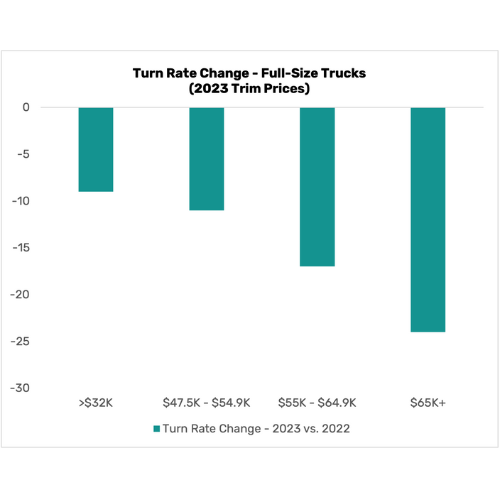
A specific vehicle example highlights these dynamics. It is generally true that with the 2023 rebound in inventories, turn rates have gone down, and this is the case for the Ford F-150 overall. But the higher-end Lariat trim, which doubled its inventory position from Q4 2022 to Q4 2023, only grew its movement by 14%, resulting in an 18-point drop in turn rate. The lower-end (and lower-priced) XLT, meanwhile, also dramatically grew its inventory position (+83%). Its movement gain, while not keeping pace with supply, came closer to matching its inventory gain (+42%), thereby seeing a smaller turn rate loss (-7 points).

Q4 2023 vs Q4 2022
.png?width=700&height=159&name=Q42023vsQ42022F150%20(1).png)
2024 Outlook and Key Considerations
The Federal Reserve, after aggressively raising rates in reaction to post-COVID inflation, has sent mixed signals about future actions going forward. The general sentiment is that rates will come down modestly and in a measured way in the latter half of the year, but there have also been signals regarding additional rate hikes in the interim. The effect on auto loan rates is expected to be equally modest, measured and back-loaded.
A recent article on the MarketWatch website pointed to the potential for dichotomous outcomes:
“The dramatic increases to auto loan rates since March 2022 have had a substantial impact on the auto industry and individual borrowers. It is reasonable to assume that lower rates would also have sizable effects on both. Without a steadfast guarantee of rate decreases, however, businesses and individuals who may be affected by rate fluctuations would still be wise to prepare for changes to the funds rate—and therefore auto loan rates—in either direction.”
Assessment
At the peak of the supply chain crisis in late 2021 and the first half of 2022, many OEMs focused production on high value/high profit models and trims to maximize the return on the vehicles that they could build. As 2023 progressed and the effects of inflation and higher interest rates cut into consumer buying power, however, consumers began shifting their purchases towards less expensive trims within models. With 2024 looking similar to 2023 in terms of interest rates, manufacturers will be well served to offer a balanced portfolio of vehicle trims that best suit the economic realities that consumers will continue to face.
With 2024 looking similar to 2023 in terms of interest rates, manufacturers will be well served to offer a balanced portfolio of vehicle trims that best suit the economic realities that consumers will continue to face.
Explore Economic Influences Further: Our Latest Articles Await
- Shifting Landscape: Pricing Above MSRP Eases as Inventory Levels Rise
- After Years of Vehicle Price Increases, a Small Dip
Jump to the Top of This Navigator
05
Eight of the Top 10 Makes Carried Over From 2022 to 2023, the Rise of General Motors Brands Demonstrates That Moving Upwards Is Achievable.
Three makes—Toyota, Kia, and Honda—stood out in terms of inventory efficiency in 2023, with each one holding the top spot in multiple months during the year. Lexus, BMW, Land Rover, and Cadillac’s appearance in the annual top 10 indicate that luxury brands also fared well.
General Motors made a big push in 2023, with Chevrolet and the aforementioned Cadillac entering the top 10, supplanting Acura and Volkswagen. Both brands improved significantly in rank, with Chevrolet moving up from 14th and Cadillac from 18th in 2022.
Inventory Efficiency Index 2023
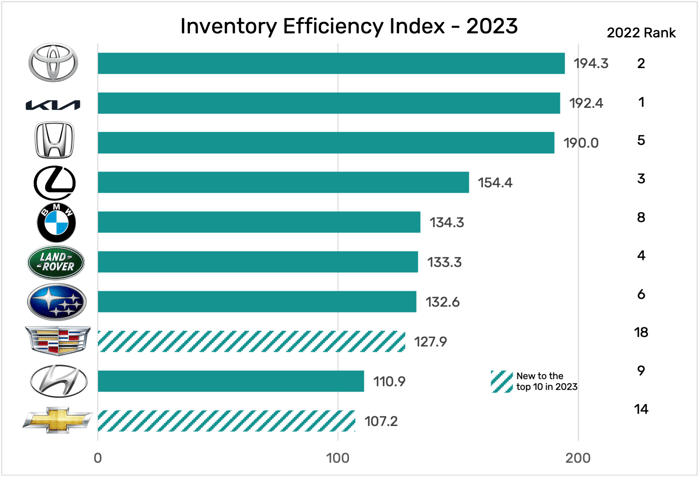
Inventory Efficiency Rank
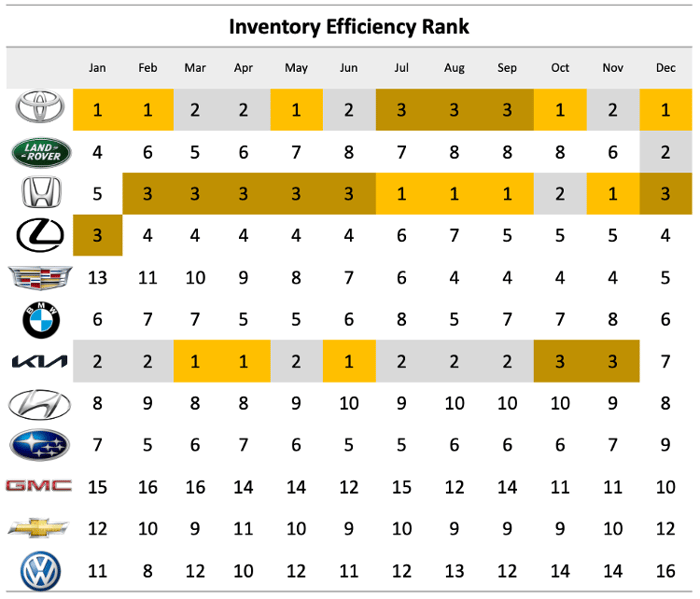
2024 Outlook and Key Considerations
Particularly in light of an environment in which supply is increasing and demand is not keeping pace, moving inventory efficiently is a key metric to evaluate and monitor. The makes that are getting more than their fair market share relative to their inventory share have an inherent advantage that makes them less dependent on pricing and incentives to sell vehicles. This is especially relevant at a time when the reliance on those pricing levers is expected to increase.
The makes that are getting more than their fair market share relative to their inventory share have an inherent advantage...
While eight of the top 10 makes carried over from 2022 to 2023, the rise of General Motors brands demonstrates that moving upwards is achievable.
Given the shifting supply and demand picture that is likely to play out in 2024, it would be prudent for OEMs to track their relative inventory and vehicles moved positions in order to adjust their approach to the market appropriately.
Conclusion
The automotive industry has proven particularly resilient over the past three years, starting with the worldwide COVID-19 pandemic and its resulting impact on the supply chain and the economy. 2023 saw circumstances move back closer to pre-pandemic normalcy, but residual factors will continue to echo into 2024. OEMs would be well served to take the positive lessons learned (e.g., more flexible parts management) without falling back into previous patterns (e.g., over-reliance on incentives) as supply and demand dynamics play out in the coming year.
Unlock Inventory Efficiency: Explore Our Top 3 Resources
- A Deeper Dive into Cloud Theory’s Inventory Efficiency Index: Unraveling the Big Picture
- Not All Inventory Efficiency Index Scores Are Created Equal
- All Four General Motors Brands Improve Inventory Efficiency in 2023
Jump to the Top of This Navigator
Want Access to Real-Time Daily Automotive Insights?
(including free competitive insights you can use today)
Request a Demo



